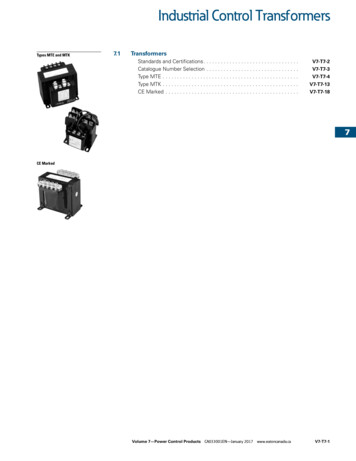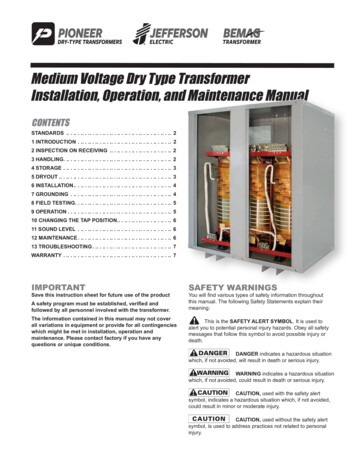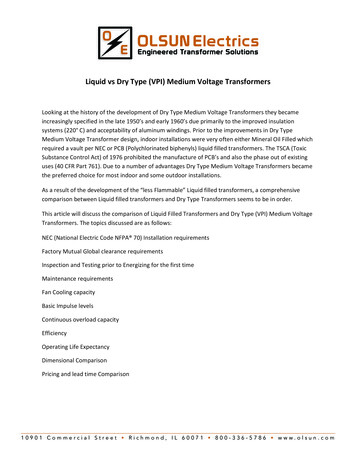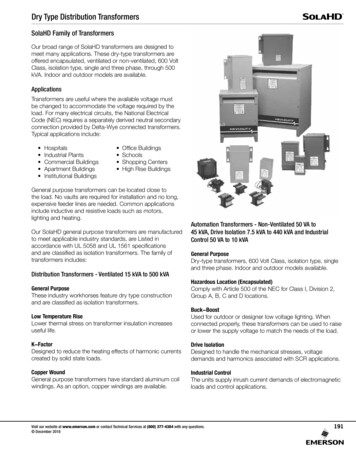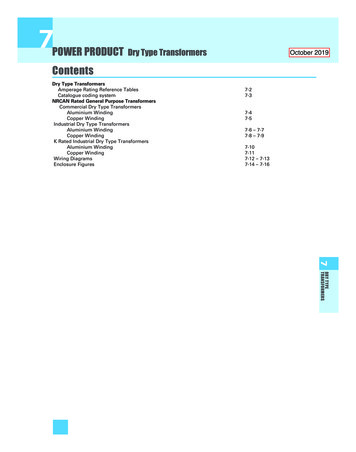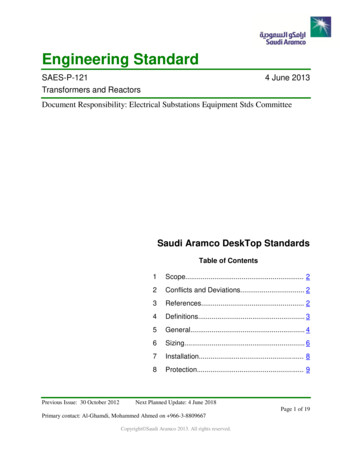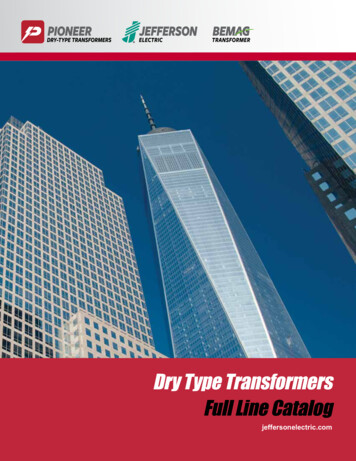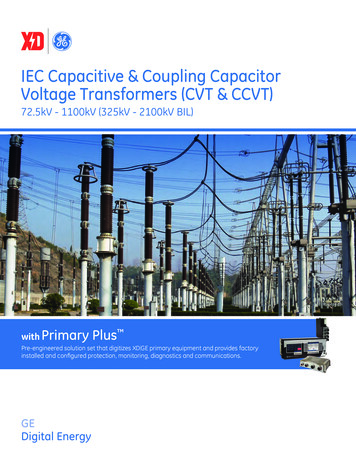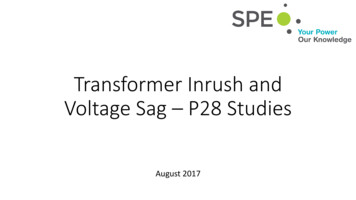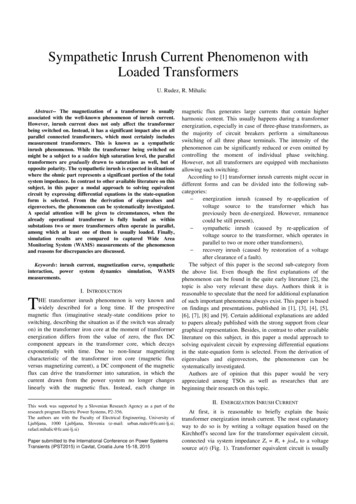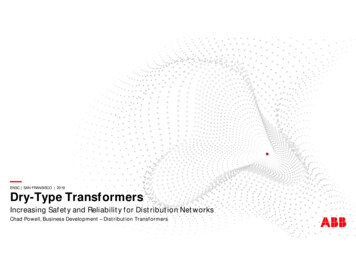
Transcription
—Dry-Type TransformersENSC SAN FRANSISCO 2019Increasing Safety and Reliability for Distribution NetworksChad Powell, Business Development – Distribution Transformers
Dry-type transformersSpeakerChad Powell– Business Development – DistributionTransformers– ABB; Power Grids– Denver, CO– 1 (720) 327-3946April 15, 2019Slide 2Switching Transient Protection - TVRT
Your safety is important to usApril 15, 2019Slide 3
Agenda- Use of distribution transformers in network systems- The potential hazards and risk associated with network distribution transformers- Understanding Risk of Ownership (failure modes, safety, protection)- A comparison between liquid filled vs dry-type network transformers- Dry-type transformers for network applications- Digital advancements in distribution network transformersApril 15, 2019Slide 4
Network TransformersWhere are network transformers used?Location & Environment:Used in major metropolitan / city environments– New York, San Francisco, Toronto, Chicago,Washington DC, many othersStandard ratingsPrimary Network Transformers Users:UserQuantityCon Ed27,000PEPCO, PSEG4,500 - 5,000Toronto Hydro,NStar2,000 – 2,500Com Ed2,000National Grid1,200 – 1,500Seattle CityLight1,500LG&E, Dominion500 - 700– kVA : 300, 500, 1000, 1500, 2000, 2500,– HV: 2400 – 34,500, LV: 216Y/125, 480Y/277City network transformers can be found inside ofdowntown buildings, outside in vaults underneathgrates in city street / sidewalk areas, or undergroundin subway tunnelsUrban utilities employ networks to eliminate the needfor overhead distribution cables running throughcongested or densely populated areasApril 15, 2019Slide 5
Why the need for a safer transformerAlthough rare, events occur and are ncial-district.htmlApril 15, 2019Slide 6There was an oil transformer accident in Toronto. Atransformer in an underground electrical vault, causingexplosions and a smoke cloud. They had to evacuated a banktower.
Network transformer failuresStreet vault examplesApril 15, 2019Slide 7Link 1Link 2
ABB Dry-Type Network TransformersVault EnvironmentsThe transformer vaults are concrete and may beoccasionally completely submerged in waterThe vaults do not have drainage systems so allsurface debris is washed off the street fromrain and into the transformer vault through thegrates aboveSome vaults that are close to waterways havecontinuous standing water in themThe average life of vault-type networktransformers is shortened due to highoverloading and tank deteriorationEnclosure “tanks” are designed with thick wallsand epoxy coatings to impede rust-throughInternal faults or short circuits can lead to large,street level events that cause significant harmto people and surrounding property65% of transformer failures due to corrosionApril 15, 2019Slide 8
Assessing Risk of OwnershipDetermining your level of riskIn the news Factors to consider:Number of units in serviceAverage age of fleetTime based maintenanceCondition assessments of individual assetsTransformers near or around peopleNumber of units older than 15 years of ageUnits in costal areas or near harsh/corrosive environmentalCondition of containment systems“One injured in transformer explosion” Istanbul, Jan 2016“3 injured in transformer explosion” Massachusetts, April 2016“Transformer explosion kills 3, injures 5” Nigeria, July 2016“7 people injured in transformer explosion” Pakistan, July 2016“2 injured in transformer explosion” South Africa, Oct 2016“Six injured in power plant [transformer] explosion”Damage and repercussions from transformerexplosions/fires as well asenvironmental fines and penalties from leaks and spills canrange from several thousands to several million dollars Cincinnati, Jan 2017“ 8.5 Million Settlement for Family of Assistant Fire Chief Killed inNeiman Marcus Transformer Fire” Chicago, June 1999April 15, 2019Slide 9
Why oil-free? Avoid rupture and fireApril 15, 2019Slide 10
—Dry-Type vs Liquid Filled TransformersUnderstanding the difference
Oil-filled and dry-type transformersThe simple differenceApril 15, 2019Slide 12Oil-filled transformersDry-type transformersUses OIL for main dielectricand cooling mediaUses SOLID INSULATIONmaterials for main dielectricsand natural AIR for cooling
Dry-type vs oil-filled solutionsKey feature advantages (generally speaking)Oil-filledFeatureDry-typeSize & WeightInitial CostLosses / EfficiencyNoiseAvailabilityOverload capabilityNo Bushings RequiredFire SafetyEnvironmental SafetyTotal Installation Cost*Maintenance CostShort Circuit Strength*Driven mostly by regional building safety codesApril 15, 2019Slide 13
Combustibility RiskTransformer oilsMineral oilEster oilsDryDry w/ Internal Fault Protection– Nonflammable, butcombustible– Nonflammable, but stillcombustible– Non-flammable AND noncombustible– Same features as standard drytype transformer– Flash point of 170 C– Flash point of 330-360 C– Largest installed base oftransformer technology– 98% biodegradable seed oil(when unused)– Flash point is negligible (no oilor fuel source to ignite)– Additional features limitdamages in rare event ofinternal arc fault– Long history of being safe– Not suggested for indoors– Only technology suited for bothindoor and outdoor applicationsIncreased safety and environmental benefits LOWER RISKApril 15, 2019Slide 14
Oil-filled and dry-type transformersThe simple differenceOil-filled transformersOil Levels / Pressure Gauge / Relief ValvesOver the life, oil filled units may have issues/symptoms that requireinsulating fluid analysis, metals analysis, dissolved gas analysis, etc.Porcelain Insulator / Surface CleaningGauges are sometimes prone to failure over timeConnections (Tighten)/ Painting StateOil Analysis (Dielectric Testing) / SILICAGERoutine preventative maintenance can be expensive if performed regularlyAccessories Checks (Over Pressure Relay, WTI, Buzcholz)Dry-type transformersSurface CleaningConnections (Tighten)Winding Temp Indicator (WTI)April 15, 2019Slide 15Very little preventative maintenance is required for a dry-type transformerto keep the transformer in good running order. Clean/Dry Environment fewer inspections and maintenance. Visual Inspections reduced risk of insulation surfaces becomingdirty and obstructing effective cooling. Within the first few inspections, a routine maintenance scheduleshould be established. Dry air cooled (ventilated) which isn’t subject to breaking down Dry sealed and requires only periodic surface cleaning
Dry-type technologyTwo predominate insulation systems availableResin based systemOpen woundEpoxy based systemsVacuum cast coil (VCC)– 80/100/115/150 C temp rises– Can reach highest voltage class for drytype transformers (145 kV/550 kV BIL)– Most economical type of transformer– 80/100/115 temp rises– Ideal for indoor environments– Insulation of epoxy 185*C– Highest insulation class (220 C) VPE can be suggested for outdoorapplications– Best suitability for corrosive, outdoorenvironments– Requires vacuuming of coils if dirty– Superior dielectric strength– Highest installed base in NAM.– Highly resistant to short circuit events– Little maintenance (NEMA 3R)– Maintenance free (Sealed Tank)April 15, 2019Slide 16
ABB Dry-Type Network TransformersSafest Power for Urban AreasVentilated NetworksSubmersible NetworksNEMA 1, 2, 3R enclosureProtection from airborne dust andwater leaksup to 5 MVA, 34.5 kVSubmersible networksComplete absence of oilEntirely welded tank assembly w/similar footprint to liquid filled unitUp to 1500 KVA, 15kVApril 15, 2019Slide 17
—Oil-free development
Primary design considerationsThermal riseLifetime expectancyInternal faultMust stay within material thermal limitswith no enclosure ventilation and limitedair flow inside the faultMust have usable life expectation of 30 years while in high thermal performanceenvironmentMust withstand most dangerous failuremode: internal electrical fault.April 15, 2019Slide 19
Getting inside the vaultLifetime expectancyFrom thermal rise testing– Able to calculate thermal rise constants at each PU load profile– At 2.04 PU, hotspot estimated to be 260 C– Time to failure under continuous loading:LV WdgHV WdgApril 15, 20191.0 PU Load1.3 PU Load1.7 PU LoadMax HS Insul. Life Max HS Insul. Life Max HS Insul. Life26 C Amb(yrs)26 C Amb(yrs)26 C 152.53194218.390.10Slide 20Thermal loss of lifecurve ABB’s UL certified194.7 C Mylar Epoxyinsulation system
ABB Dry-Type Network TransformersType TestingCustom Design Validation:Full type certification– Applied potential, double induced, 95 kV, 100% fullwave impulse– Short circuit test at 25x rated current for 2 sec– (3) High fault energy resistant for an arc current up– (1) @ 47.5 kA, (2) @ 38 kA for 100 milliseconds– Through fault test on ground switch– 24 hr applied potential @ 18 kV (1.33%) ofnameplate rating– Audible sound test – 47.4 dBASuccessful thermal testing in a wooden replica vault at170% of nameplate power ratingSimulated transformer life in excess of (40) years underuser loading profileApril 15, 2019Slide 21
ABB Dry Type Network TransformersEnsuring against the worst failure modeInternal Arc Fault Testing:Three internal arc fault test were conductedidentical designs to prove safetyTests conducted at KEMA labs– (1) 47,500 amp arcs generated (7 in. gap)– (2) 38,000 amp arcs generated (7 in. gap)– Over 10 MJ of energy dissipated– 100 PSI pressure change in 0.15millisecondsAll (3) trials successfully passedPerformed post weld and steel analysis withno indications of degradationApril 15, 2019Slide 22
—Implementation and results
Submersible Dry-Type Network TransformerSealed ; Maintenance FreeProduct Features: Capable of 70% overloadingSimilar in size to liquid-filled units withcooling finsSafest failure mode for submersibleapplicationsUp to 1500 kVA, 27 kV available fororderTwo position ground switch availablefor orderThree position ground switch and / ortap changing capability available forpilotAs close to maintenance free aspossibleCan be utilized in Class 1 Div 2ApplicationsApril 15, 2019Slide 24N2 Gas OverpressureOverpressure of 5 psi, nonflammable and non-corrosiveN2 gas with monitoring togive warning when tankdeterioration has occurredEpoxy Winding InsulationPrimary vacuum cast coil (VCC),185C insulation class; secondary isepoxy encapsulated high 220Cinsulation systemWelded Tank AssemblyCompletely welded, subwaytype tank assembly2-Position Ground SwitchDry-type disconnect switchwith solenoid interlockingfor clear and groundconnectionsHV tap changer95 kV BIL primary,no load tapchangerStadium Core & Oval CoilShapeOptimized coil and coreshape to reduce total weightand length of design. Aspectratio over 2.0.
ABB Dry Type Network TransformersExisting Protector & TransformersThree (3) – 167KVA single phase transformers bankedtogether in high rise with remote mount network protector.Customer driven to eliminate oil from the buildingExisting Installation /Location & RemovalApril 15, 2019Slide 25
ABB Dry Type Network TransformersNew InstallationReplaced all single phase banked transformers with one 500KVA rated dry type networktransformer. Protector mounted on the tank wallApril 15, 2019Slide 26
ABB dry type network transformers500 kVA, 15 kV installed Aug 26th, 2011HurricanesHas survived (2) hurricanes: Irene and Sandy.– Submerged under 20 ft of water duringSandy and still functioningHad a gradual loss in N2 over pressure due toan loose fitting. Checked/tightened allconnections and refilled in Dec. 2012; hasmaintained pressure to date with no otherissues.Have installed additional 6 units in the groundsince 2013 and in the process of installing anadditional 25 units currently.April 15, 2019Slide 27
ABB Dry-Type Network TransformersNew installationExample: 50 California St, San FranciscoLocation of Vault: 37th FloorPG&E, ABB and Sheedy Drayage coordinatedwith customer on removal of old transformersand placement of new transformersInstallation of roof top crane needed and thiswas tied to building frame members (I-beams)New dry type transformers weigh more thanolder oil filled unitsStructural and seismic studies required todetermine modifications to vault (newtransformers required seismic tie downs, onlyslight modifications to vault)April 15, 2019Slide 28
But, we live in an ever changing world Though robust, transformers will not last forever; externalities shorten life expectanciesAging equipmentAs electrical equipment naturallyapproaches end of life, theysubject networks to faults andtransients causing disturbancesEnvironmental forcesNatural disasters, changingclimates and electrical storms allstress grid equipmentthroughout their lifetimesDistributed generationIncreasing demandPower is now flowing in alldirections, creating newchallenges for established gridnetworksGrowing need for AC to DCconverting subjects electricalnetworks to increasedharmonics and transientsExternal stresses are the number one cause of failure of dry-type transformersApril 15, 2019Slide 29
External stresses may affect life expectancesIdeal transformer life curveStressIdeal transformer resiliency curveElectrical stressOperationalstressTimeApril 15, 2019Slide 30 Aged timeline is exaggerated for demonstrationPlannedend of life
External stresses may affect life expectancesRealistic transformer life curveStressExtremeweather eventIdeal transformer resiliency curveSystemfaultAged transformer resiliency curveElectrical ingeventUnplannedoutagePlannedend of lifeTimeUnplanned outages are costly and result in significant downtime. With proper monitoring, they can be avoided.April 15, 2019Slide 31Aged timeline is exaggerated for demonstration
The age of digitalization – smart transformersBringing analytics for predictability and asset managementCurrent Features:Provides valuable information on how the transformer is operating.Maintenance planning, condition-based asset management, diagnosing &real time remote monitoring (Wi-Fi & LAN)Data can be logged and stored for up to 20 years (fully encrypted)Transformer consumed life & total harmonic distortionSensing & Output Features: Voltage, Current, Load Analytics Transformer lifetime, THD Asset Management AlartsApril 15, 2019Slide 32
Digital dry-type transformersAdditional features for increased monitoring and ease of useFan controlConnectivity– Standard fan trip,alarm relays andprogrammable forauto exercising– RFID and digitalcertificate protectedlocal WiFi signal toallow for wirelessconnection and datadownload– Fan monitoringsensors to notify in theevent of a fan motorfailure– Provided Ethernethard-wire connectionfor remote accessApril 15, 2019Slide 33Certified– EMI/EMC, IEC 610004-X series for electricaland magneticinterference,IEC61326-1, IEC\EN61010– Sensor package andprocessing unit doesnot affect the ULlisting or CE mark ofthe transformerFlexibility– Does not affecttransformer operationor size and works withmost indoor andoutdoor applications– Capable of futureexpansion for newhardware and softwareupgrades
Today’s situation Dry-type transformers are the safest and most reliable transformers on the grid.Eliminated risk offires or explosionsEliminated risk ofoil leaks or spillsLower ownershipcostsLow to no maintenancerequirementsLower load lossesApril 15, 2019Slide 34Lower total installationcostsNo need for oilcontainment or firesuppressionLess code restrictionsNo insurance premiumsIndoor and outdoorinstallations
Q&A and Contact informationIf you have questions, please contact me furtherSpeakersChad Powell– ABB, Inc.– Business DevelopmentPhoto– 1 (720) 327-3946– chad.powell@us.abb.comApril 15, 2019Slide 35
Apr 15, 2019 · “7 people injured in transformer explosion” Pakistan, July 2016 “2 injured in transformer explosion” South Africa, Oct 2016 “Six injured in power plant [transformer] explosion” Cincinnati, Jan 2017 “ 8.5 Million Settlement for Family of Assistant Fire Chief Kille
